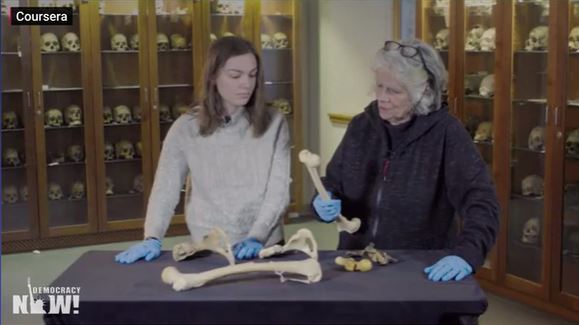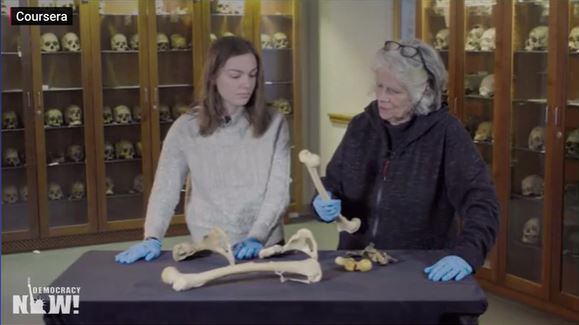‘That’s Not How We Process Our Dead’: Princeton, UPenn Heavily Criticized for Harboring Bones of Black Child Killed In 1985 Police Bombing, Vow to Return Remains
A pair of Ivy League universities apologized recently for mishandling the bones of a Black teen killed in a 1985 Philadelphia police bombing.
The child’s remains remained at the University of Pennsylvania Museum of Archaeology and Anthropology for decades and were used as an exhibit for an online forensic anthropology class that Princeton University hosted. Neither of the prestigious schools asked for consent from the child’s surviving loved ones to use her remains for teaching and research purposes.
Both schools came under fire last week after Philadelphia news team Billy Penn broke news that the remains sat in a box at the Penn Museum and were shuffled between the two campuses before resurfacing as a “case study” in a 2019 research video.
Princeton hosted the class via the online platform Coursera. It was taught by Janet Monge, a visiting adjunct professor from the University of Pennsylvania. The class has since been suspended in the wake of the recent outcry.

The remains were the pelvis and femur of an unidentified Black girl pulled from the ashes of a 1985 fire. Police dropped C4 explosives from a helicopter onto the West Philadelphia headquarters of MOVE, a Black anti-police brutality liberation group. The blast and ensuing inferno leveled a full city block and destroyed 61 homes in the predominantly Black neighborhood.
The Philadelphia city council issued a formal apology for the aerial bombing in November and was set to stage an inaugural day of remembrance for the tragedy on May 13, the 36-year anniversary of the atrocity.
Eleven MOVE members that lived in the compound were killed, including five children aged seven to 14. Among them was a teenage girl named Tree Africa, who was either 12 or 14. Her mother was a MOVE member who was in prison at the time, serving a sentence tied to an August 1978 police siege at the organization’s communal house. Her name derived from her love of climbing trees.
Delisha Africa, 12 at the time, was one of the other children killed in the bombing. Her parents were also in prison for the so-called Move 9 encounter from 1978.
The bones have never been definitively identified. Anthropologists believe the remains are those of one of the two girls. Both children’s respective parents thought they’d been buried. Neither of their families was aware that their bones were being used as research specimens.
The revelation that the bones remained in the custody of the universities without the families’ consent or knowledge 36 years later sparked outrage in both communities. It also reignited concerns of how academia misuses Black remains and how African-American corpses have been desecrated historically in the name of science.
Princeton students held on-campus protests Wednesday, April 28. At the same time, MOVE members protested at the Penn Museum in Philadelphia. Both schools issued apologies in the wake of the backlash, promising to return the remains to the child’s family.
Alan Mann, a former University of Pennsylvania anthropologist and Princeton emeritus professor at the center of the controversy, confirmed to the Philadelphia Inquirer that he turned the remains over to a West Philadelphia funeral home Friday.
“This is not just about giving these bones back, this is about restitution and accountability,” Michael Africa Jr., one of Tree Africa’s childhood friends, told the Guardian. “If I, as a Black person, went to any grave and took bones, I’m going to jail,”
The Penn Museum said it had an “ethical imperative to show the utmost respect to family survivors” in a statement that university officials issued April 28 via the school’s newsletter Penn Today.
“Informed consent must be given by the person before death or by the family afterwards,” the statement indicated. “Regretfully, this did not happen in this case—and it was a serious error in judgment to use these remains in a class of any kind, especially given the extreme emotional distress in our community surrounding the 1985 bombing of the MOVE house. Unquestionably, the decision to use the remains in this way has torn at old wounds that our city and community have long sought to heal,” the apology continued.
Princeton’s president Christopher L. Eisgruber issued an apology statement the same day, saying he was “deeply troubled” to learn that the MOVE remains were used for a course on the school’s private New Jersey campus. Like the University of Pennsylvania, Eisgruber announced a fact-finding investigation by outside attorneys to find out what happened to the remains over the years. Both schools pledged to issue reports sharing their findings.
“Princeton University’s commitment to teaching and scholarship in the service of humanity depends on treating everyone we encounter with dignity and respect,” his statement said. “This includes our campus community, the community at large, and those we encounter through our scholarship. It is important to find and share the facts when we fall short, and to take corrective action that allows us to realize our commitment and fulfill our responsibilities.
Much about the remains’ convoluted chain of custody over the years is still a mystery. The Philadelphia Medical Examiner’s Office turned charred bone fragments culled from the ashes of the MOVE house over to University of Pennsylvania anthropologists for help identifying them. That’s how they fell into the hands of Alan Mann in the immediate aftermath of the bombing.
Mann kept the remains in his possession and took them with him to Princeton when he transferred to the Ivy League university in 2001. The remains bounced between the two campuses for the next 18 years, according to the Guardian. They languished in a cardboard box at the Penn Museum for many of those years.
They re-emerged in 2019 when Janet Monge, a leading specialist who worked at the museum, filmed the training video for her online course using the pelvis and femur as exhibits. In the video, she described the bone fragments and detailed the 1985 Philadelphia bombing, which she called “one of the great tragedies.” She said the pelvis was cracked from a beam of wood that fell on the child. Monge described the sheen on the femur, which still contained bone marrow, noting that was indicative of how relatively recent the death was.
More than 5,000 students were enrolled in Monge’s online anthropology course, which she taught until late last month, using the bones as a central prop.
“Nobody said you can do that, holding up their bones for the camera. That’s not how we process our dead,” a frustrated Michael Africa told the Guardian. “This is beyond words. The anthropology professor is holding the bones of a 14-year-old girl whose mother is still alive and grieving.”
When questioned about the remains by reporters, Princeton officials initially claimed they weren’t aware of the location. University of Pennsylvania later admitted that Mann had them and would release the bones.
Princeton’s anthropology department issued a collective statement with the Association of Black Anthropologists, the Society of Black Archaeologists, and the Black in Bioanthropology Collective. The three groups condemned Monge, Mann, the online course and both universities for the “unfathomable heartlessness and disrespect” they showed the Africa families.
“(We) are painfully aware of the barbaric history of anthropology, especially when it comes to populations of peoples of African descent,” the statement said. “We know that our discipline has been mobilized to rationalize eugenics and white supremacy and to justify slavery and colonialism. We also know that ethnographic museums, like Penn’s Museum of Archaeology and Anthropology — which houses the collection of the notorious racist Samuel Morton — have supported the academic rationale for the institutionalization of racism in anthropology textbooks, courses, and curricula.”

